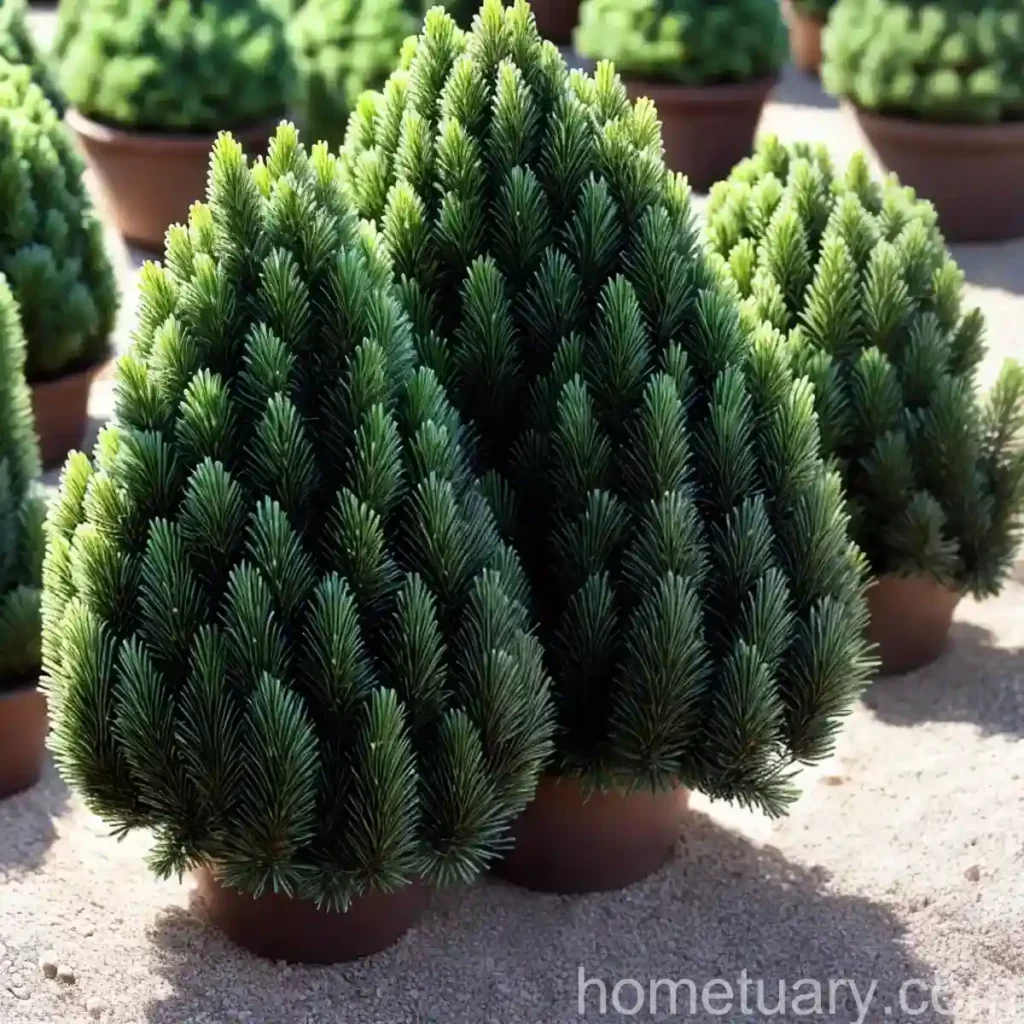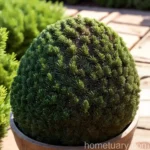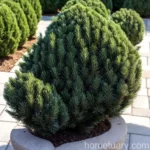Colorado Spruce (Picea pungens ‘Glauca Prostrata’): A Plant Scientist’s Guide

As a plant scientist, I find myself drawn to the diverse and fascinating world of plants. Among the multitude of species that exist, conifers hold a special place due to their unique characteristics and versatility. Colorado spruce, scientifically known as Picea pungens ‘Glauca Prostrata,’ is a captivating conifer that is renowned for its stunning appearance and adaptability. In this comprehensive guide, I will delve into the various aspects of caring for and appreciating the Colorado spruce, providing insights into its culture, uses, care requirements, common diseases, pests, and much more.
What is Colorado Spruce (Picea pungens ‘Glauca Prostrata’)?
Colorado spruce, a variant of the native Colorado blue spruce, is a remarkable evergreen conifer known for its striking blue-green needles. It is a low-growing, spreading form of the species, hence the name ‘Glauca Prostrata.’ This unique cultivar boasts a distinct prostrate growth habit, making it an exceptional choice for landscape design and ornamental gardening.
Key Takeaways – Colorado Spruce (Picea pungens ‘Glauca Prostrata’)
Before delving deeper into the care and cultivation of Colorado spruce, let’s outline some key takeaways regarding this captivating conifer:
- Botanical Name: Picea pungens ‘Glauca Prostrata’
- Common Name: Colorado spruce
- Growth Habit: Low-growing, prostrate form
- Foliage: Blue-green needles
- Versatility: Excellent for landscape use and ornamental gardening
- Unique Characteristics: Distinct prostrate growth habit sets it apart from other variants of the species
- Hardiness: Well-suited to diverse climatic conditions
Now that we have an overview of the Colorado spruce, let’s explore its culture, uses, and the essential factors for its optimal growth and development.
Culture
Understanding the cultural requirements of the Colorado spruce is crucial for cultivating and maintaining its health and vitality. From water and sunlight needs to soil preferences and fertilizer application, each aspect contributes to the overall well-being of this conifer.
Water
Colorado spruce, like many evergreen trees, thrives in well-drained soil and is relatively drought-tolerant once established. However, adequate moisture is crucial during its initial establishment period and in periods of extended dryness. Here are some essential considerations for watering Colorado spruce:
- Establishment: During the first year after planting, regular watering is essential to support root development. It’s important to keep the soil consistently moist but not waterlogged.
- Mature Trees: Once established, Colorado spruce generally requires less frequent watering. However, it’s important to monitor soil moisture levels during dry spells and provide supplementary irrigation as needed to prevent drought stress.
Sunlight
Colorado spruce prefers full sun to partial shade for optimal growth and development. When selecting a planting site, it’s crucial to ensure that the tree receives sufficient sunlight throughout the day, especially in regions with cooler climates.
- Full Sun: Ideal for promoting healthy growth and vibrant foliage color.
- Partial Shade: Tolerated, particularly in regions with intense sunlight or high temperatures. However, ample sunlight is still necessary to support robust growth.
Fertilizer
Proper fertilization is instrumental in maintaining the vigor and vitality of Colorado spruce. While it is generally a low-maintenance tree, providing balanced nutrition can enhance its overall health and appearance. Here are some fertilizer guidelines to consider:
- Timing: Apply fertilizer in early spring before the onset of new growth to support the tree’s nutritional needs during the growing season.
- Fertilizer Type: Use a slow-release, balanced fertilizer specifically formulated for conifers to provide essential nutrients without causing rapid and excessive growth.
- Application: Apply fertilizer evenly around the tree, extending beyond the drip line. Water thoroughly after application to aid in nutrient absorption.
Soil
Proper soil conditions are pivotal in ensuring the well-being of Colorado spruce. It thrives in well-drained, slightly acidic soils with good fertility and moisture retention capacity. When cultivating Colorado spruce, consider the following soil-related factors:
- Drainage: Ensure that the planting site provides adequate drainage to prevent waterlogging, which can lead to root rot and other issues.
- pH Level: Colorado spruce prefers slightly acidic soil with a pH range of 5.5 to 7.0. Conduct a soil test to assess the pH and adjust as needed using appropriate amendments.
- Soil Composition: Loamy, well-aerated soils rich in organic matter are ideal for supporting the growth and development of Colorado spruce.
Uses
Colorado spruce, with its notable beauty and unique growth habit, holds significant value in various horticultural and landscaping applications. From serving as a focal point in garden designs to providing year-round interest in residential and commercial landscapes, this conifer offers a multitude of uses.
Landscape Specimen
As a low-growing, spreading conifer, Colorado spruce ‘Glauca Prostrata’ is highly prized as a striking landscape specimen. Its distinctive silvery-blue foliage and prostrate form make it an eye-catching addition to gardens, parks, and public spaces, imparting a sense of elegance and charm.
Ground Cover
Due to its spreading growth habit, Colorado spruce is utilized effectively as a ground cover plant in larger landscapes and expansive garden areas. Its dense foliage provides excellent coverage and weed suppression, creating a visually appealing and low-maintenance ground cover.
Erosion Control
The spreading nature of Colorado spruce makes it an effective choice for controlling soil erosion on slopes and embankments. Its dense root system helps stabilize the soil, preventing erosion and enhancing the overall landscape’s stability and aesthetics.
Container Planting
While Colorado spruce is primarily known for its use in landscaping, it can also thrive in container gardens, providing a captivating focal point on patios, decks, or other outdoor living spaces. Its adaptability to container planting makes it a versatile choice for urban and small-scale gardening applications.
Pruning
Proper pruning is essential for maintaining the health, shape, and overall appearance of Colorado spruce. While this conifer is known for its dense, compact growth habit, occasional pruning can help manage its size, remove dead or damaged branches, and promote airflow within the canopy.
Timing
The best time to prune Colorado spruce is during the dormant season in late winter or early spring. Pruning during this time minimizes stress on the tree and allows for optimal wound healing and new growth in the upcoming growing season.
Techniques
When pruning Colorado spruce, focus on the following key techniques to achieve desirable results:
- Dead Branch Removal: Regularly inspect the tree for dead or diseased branches and promptly remove them to prevent potential spread of disease and enhance the tree’s overall health.
- Selective Pruning: Use selective pruning to maintain the tree’s natural form while shaping its growth and addressing any overcrowding or crossing branches within the canopy.
- Minimal Trimming: Colorado spruce generally requires minimal pruning, as excessive removal of healthy foliage can disrupt its natural beauty and compact growth habit.
Propagation
Propagating Colorado spruce can be achieved through several methods, including seed propagation, cutting propagation, and grafting. Each method offers unique advantages and considerations, allowing for the propagation of new plants with desirable characteristics.
Seed Propagation
While Colorado spruce can be propagated from seeds, this method is most commonly used in breeding programs to develop new cultivars or variants with specific traits. If you are interested in seed propagation, consider the following key points:
- Seed Collection: Gather seeds from mature cones in the fall when they are fully developed.
- Stratification: Seeds typically require a cold stratification period to break dormancy. Store them in a cool, moist environment for a specific duration before sowing.
Cutting Propagation
Propagating Colorado spruce from cuttings is a popular method for reproducing plants with consistent characteristics and traits. Here’s a brief overview of the cutting propagation process:
- Cutting Selection: Choose healthy, young shoots for taking cuttings, typically in early summer.
- Rooting Hormone: Apply a rooting hormone to the base of cuttings to stimulate root development.
- Growing Medium: Plant the cuttings in a well-draining growing medium and provide consistent moisture and humidity to support root initiation.
Grafting
Grafting is another method employed for propagating Colorado spruce, particularly when seeking to preserve the unique characteristics of a specific cultivar. It involves joining a scion (desired cultivar) onto a rootstock, facilitating the propagation of the desired traits.
Container Popularity
The compact size and striking appearance of Colorado spruce ‘Glauca Prostrata’ make it an ideal candidate for container gardening. Its adaptability to container growth allows for its inclusion in various urban and small-space gardening settings, as well as enhancing outdoor living areas with a touch of natural elegance.
Container Considerations
When growing Colorado spruce in containers, it’s essential to consider the following factors for its successful cultivation:
- Container Size: Select a sufficiently large container to accommodate the root system and allow for adequate growth. Ensure that the container has drainage holes to prevent waterlogging.
- Growing Medium: Use a well-draining, high-quality potting mix suitable for conifers to provide adequate aeration and moisture retention for the tree’s roots.
- Watering and Maintenance: Container-grown plants may require more frequent watering and maintenance. Monitor soil moisture levels regularly and provide proper care to ensure the tree’s vitality.
Common Diseases
Colorado spruce, like many conifers, is susceptible to certain diseases that can affect its health and vigor. Being aware of these diseases and their associated symptoms is crucial for implementing proactive disease management strategies.
Disease Diagnosis
Here are some common diseases that may affect Colorado spruce ‘Glauca Prostrata,’ along with their diagnostic symptoms:
- Rhizosphaera Needle Cast: This fungal disease causes browning and premature shedding of needles, typically starting from the lower branches and progressing upward. The presence of black fruiting bodies on infected needles may also be observed.
- Cytospora Canker: Cytospora canker manifests as sunken, discolored areas on the branches, often accompanied by resinous sap exudation. The affected branches may exhibit dieback, and the overall health of the tree may decline.
- Needle Rust: Needle rust infections result in the development of rust-colored pustules on the needles, typically on the lower surface. Severe infections can lead to defoliation and reduced vigor.
Disease Prevention
Implementing preventive measures can greatly reduce the risk of disease in Colorado spruce. Here are some key practices for disease prevention:
- Site Selection: Choose well-ventilated planting sites with good air circulation to prevent moisture buildup, which can contribute to disease development.
- Sanitation: Regularly remove and dispose of fallen needles and affected plant debris to minimize disease inoculum in the vicinity of the tree.
- Fungicide Applications: In cases where disease pressure is high or recurrent, consider applying fungicides according to recommended guidelines to manage pathogens effectively.
Common Pests
In addition to diseases, Colorado spruce may also encounter various pests, including insects and mites, which can potentially impact its health and appearance. Recognizing the signs of pest infestations is vital for implementing appropriate pest control measures.
Pest Identification
Several pests may affect Colorado spruce, with some of the most common ones being:
- Spruce Spider Mites: These tiny arachnids feed on the needles, causing stippling, discoloration, and webbing. Severe infestations can lead to defoliation and weakened tree vigor.
- Spruce Needle Miners: The larvae of needle miner insects tunnel within the needles, resulting in blotchy, discolored areas and potential needle drop.
- Spruce Gall Adelgids: These insects cause the formation of galls on the needles, affecting the overall appearance and health of the tree.
Pest Control
Integrated pest management (IPM) practices encompass a range of strategies for managing pest infestations while minimizing environmental impact. Consider the following approaches for pest control in Colorado spruce:
- Cultural Practices: Maintaining tree vigor through proper cultural practices, such as watering, fertilization, and pruning, can enhance the tree’s natural resilience to pest attacks.
- Biological Control: Encouraging natural predators of pests, such as predatory mites, can help regulate pest populations and reduce their impact on the tree.
- Insecticidal Treatments: In cases of severe infestation, targeted insecticidal treatments may be warranted. Opt for selective insecticides that minimize harm to beneficial insects and the environment.
Botanist’s Tips
As a plant scientist with a passion for conifers, I would like to share some valuable tips for cultivating and appreciating Colorado spruce in residential and landscape settings. These insights can contribute to the successful growth and long-term vitality of this striking conifer.
- Appreciate Its Unique Form: Colorado spruce ‘Glauca Prostrata’ exhibits a captivating prostrate growth habit, making it an exceptional choice for adding visual interest to gardens and landscapes. Embrace its unique form and integrate it creatively into the overall design.
- Monitor Moisture Levels: While Colorado spruce is relatively drought-tolerant once established, it’s crucial to monitor soil moisture levels, especially during periods of prolonged dryness. Maintaining adequate moisture is key to supporting its overall health and appearance.
- Promote Air Circulation: Prune Colorado spruce selectively to enhance air circulation within the canopy, which can help minimize the risk of disease and pest issues while promoting the tree’s vigor.
- Stay Informed about Diseases and Pests: Regularly educate yourself about common diseases and pests that may affect Colorado spruce, enabling you to implement timely management strategies to safeguard its well-being.
- Adopt Sustainable Practices: Embrace sustainable and environmentally friendly horticultural practices when caring for Colorado spruce, such as utilizing organic amendments, practicing integrated pest management, and conserving water.
Fun Facts
Delving into the realm of fascinating plant trivia can offer delightful insights and deepen our appreciation for the natural world. Here are some fun facts about Colorado spruce that are sure to pique your interest:
- State Tree of Colorado: Colorado spruce holds the distinction of being the state tree of Colorado, where it is highly esteemed for its beauty and resilience in diverse climatic conditions.
- Winter Interest: The striking blue-green foliage of Colorado spruce adds a pop of color and visual interest to winter landscapes, making it a sought-after choice for year-round appeal.
- Wildlife Habitat: Colorado spruce provides valuable habitat and cover for various wildlife species, including birds and small mammals, enhancing biodiversity in its surroundings.
- Longevity: When provided with optimal growing conditions, Colorado spruce can live for several decades, gracing landscapes with its enduring presence.
Links to External Resources
For further exploration of Colorado spruce care and related topics, the following external resources offer valuable information and insights:
-
Colorado State University Extension – Colorado Blue Spruce for Landscape Planting: This comprehensive guide provides detailed information on the cultivation and landscape use of Colorado blue spruce, offering practical recommendations for homeowners and gardeners.
-
The American Conifer Society: The American Conifer Society website is a valuable resource for conifer enthusiasts, featuring a wealth of information on a wide range of conifer species, including Picea pungens and its variants.
-
Integrated Pest Management for Spruce Trees: This resource offers insights into integrated pest management strategies for protecting spruce trees from pests while minimizing environmental impact, providing practical guidance for pest control.
-
University of Illinois Extension – Caring for Evergreens: The University of Illinois Extension offers an informative resource on caring for evergreen trees, including guidance on watering, pruning, and disease management.
In conclusion, Colorado spruce (Picea pungens ‘Glauca Prostrata’) stands as a captivating conifer with outstanding ornamental value and versatility. By understanding its culture, uses, care requirements, and associated factors, we can cultivate and appreciate this remarkable tree while enhancing our natural surroundings with its enduring beauty.
As a plant scientist, I am continually inspired by the diverse and wondrous world of plants, and the Colorado spruce serves as a compelling example of nature’s splendor and resilience. I hope this guide provides valuable insights and inspiration for incorporating Colorado spruce ‘Glauca Prostrata’ into your botanical endeavors and landscape designs.
The information provided in this guide is based on the scientific understanding of plant care and horticultural practices. It is important to consider local climate, growing conditions, and specific plant health requirements when applying these recommendations. For personalized advice, consult with local horticultural experts or extension services for tailored guidance on caring for Colorado spruce and other plant species.















